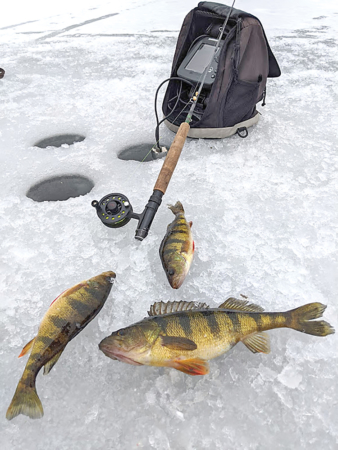When it comes to fishing, the yellow perch doesn’t seem to get much attention; it’s probably not the most talked-about species, and it certainly doesn’t get a lot of attention in the written form either. While it doesn’t get a lot of attention, it is a frequently caught fish and, in some cases, one of the most sought-after species. Ice fishermen often target the yellow perch along with bluegills and crappies, and few would argue with the fact that the yellow perch ranks at the very top for eating quality. Although commonly caught by ice-fishermen, the perch can often be taken at almost any time of the year.
The yellow perch is usually found in lakes and ponds throughout the state, but without doubt, the biggest and probably some of the best perch fishing is in Lake Erie and Presque Isle. In fact, the state record yellow perch was taken from Presque Isle Bay in 2016, and it weighed 2 lbs. 14 oz. I’m guessing that fish came in at around 16 or 17 inches, and when you are used to catching fish little more than half that length, that’s a pretty impressive catch.
Yellow perch are one of the easiest species to identify; their fairly long body is adorned with two dorsal fins (the fins on top of the back), one spiny ray, and the other is a soft ray fin. As the name implies, it is usually yellowish with dark bands running from back to near the belly with some orangey color showing up in the pelvic and pectoral fins.
While it’s true that perch may not have the best reputation for their fierce fighting ability, they more than make up for it as table fare, as I already mentioned. Perch are often abundant to the point that they become somewhat stunted and do not reach even a good eating size, so in most cases, it doesn’t hurt the fishery to remove some for eating; eight or nine inches at the least makes for reasonable filleting.
Perch are often very cooperative when it comes to catching, but finding the cooperative fish can be a challenge at times. During the winter months, we ice-fishermen will usually probe the deeper water, but in spring and fall, you are probably better off fishing the shallower bays and shorelines. In early spring, when water temperatures hit around 40 degrees perch, move to the shallower water to spawn; they also hit the shallows again in the fall. The shallow water periods can be fairly brief, and you need to move to deeper water as the weather warms.
Once located, fishing two to three-inch live minnows can be deadly. Several methods work; in the shallow water, a live minnow lip hooked on a one thirty-second ounce or slightly larger jig is a good choice. You can also attach the minnow several feet below a small bobber-adjust the depth until you start hitting fish. I have also done well fishing a small plastic grub-usually yellow or white on a small lead head jig. If you are fishing deeper water, you may want to switch to a slip bobber to adjust for the deeper water or simply fish the plastic grub or live minnow with the appropriate size jig.
By the way, the perch family includes the much larger walleye and sauger-also excellent table fare and fun to catch sometimes even in the same lake. The state’s top walleye was taken in the Allegheny Reservoir in Warren County in 1980; it weighed 17 lbs. 9 oz. The state’s top sauger was taken by Tim Waltz of Williamsport in the Susquehanna River, Lycoming County-it weighed four pounds. Sometimes the big ones are right here in our own backyard.
1 comment




1 Comment
John Ross
January 7, 2022, 4:58 pmI love yellow perch. I used to live on the north bank of Lake Stfransis. This is part of the St Lawrence River. Between Valleyfield Quebec and Cornwall Ontario. There used to be so many perch that there was no limit or season. Now there is a season and a limit. I think it was from over fishing them by the Commercial Fisheries and the amount of Algiers (moss) in their spawning beds.and also the chemicals from the cash croppers. That’s probably why they have those regulations?
REPLY